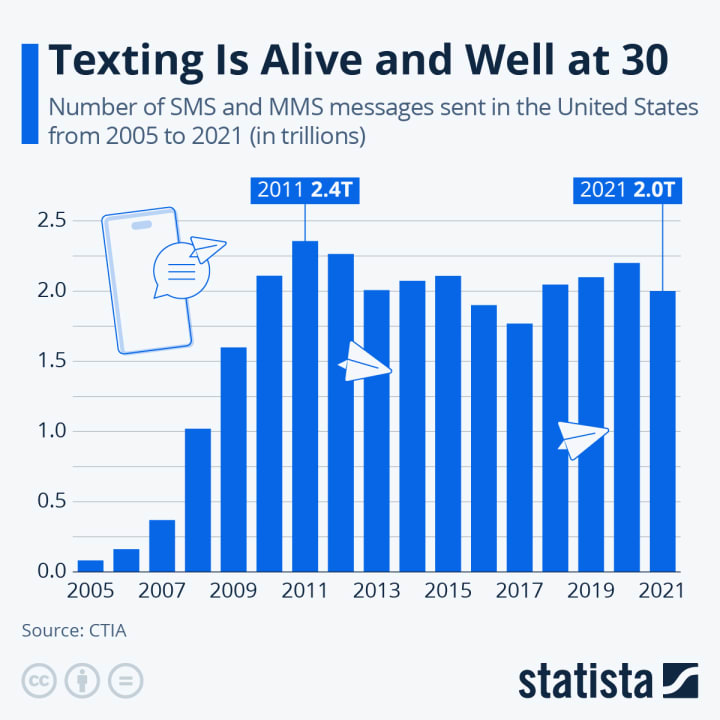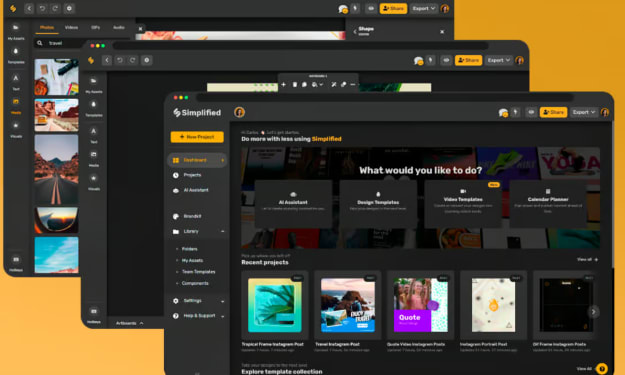OMG! TBH, Texting is Still a GR8 Communication Tool ATM
Recent data shows that despite all the alternatives out there for communicating instantly with one another, the “old fashioned” text is still a vital communication tool for all of us - and a key success factor for your career!
Introduction
The humble text message. There are so many different - and inarguably, technically and operationally better - ways for us to instantly connect today. With just a swipe and a few taps on your smartphone, you can instantly communicate with literally anyone on the planet. We have the means today to freely - and yes, literally for free in terms of cost as well - communicate not just with written (well, typed-out) text messages. Today, you can interact with full audio and video that allows us to communicate far more richly with one another (or with tens, hundreds, thousands of others!) than through just a text. And as opposed to texting with one another, whether with one person or with a whole group of people, whether we are talking about FaceTime calls, Zoom meetings, or a whole range of other communications platforms today, texting has one, never to be overcome hurdle that can’t - simply cannot - be overcome. This is because texting is asynchronous (meaning that you cannot be interacting in “real time,” but rather sequentially), as opposed to all the various forms of synchronous communications that allow for 1, 2, 10, a hundred… people to all be heard - and seen - as with all the video meeting/conferencing apps and platforms available today - and interact in real time!
And yet, recent research shows that texting is not going anywhere! In this article, we will take a look at why texting is still arguably one of - if not the -most important communications tool in the communications toolkit today, despite the fact that there are newer and far better ways of communicating with one another.

Trillions of Texts (Still)
The data analysis firm, Statista, recently released a research report entitled, “Texting Is Alive and Well at 30.” It was authored by Martin Armstrong, a senior data journalist with the firm. Believe it or not, text messaging is now 30 years old, as the first text ever was sent back in December 1992 by Neil Papworth, then a 22-year-old software programmer (and now the Senior Cloud Practice Architect for Onica) who developed a “short-messaging service” (SMS) for Vodafone. The first text message, sent by Papworth to a colleague, was simply “Merry Christmas!” But as we all know, from that humble beginning, texting has become an integral part of how people communicate all around the world. Armstrong took the occasion of the 30th anniversary of that first text message to produce a report on the state of texting in the United States today. And if you thought texting was on the wane, the data shows that to be far, far from the case!
Take a look at Figure 1 (Number of SMS and MMS Messages Sent in the United States from 2005 to 2021 [in Trillions]). As you can see, according to an analysis of source data from CTIA, the wireless industry’s leading trade association, the number of SMS (Short Messaging Service - which transmits traditional text messages, up to 160 characters, between devices) and MMS (Multimedia Messaging Service - which transmits a text with an attached file, like a picture, video, emoji, or a website link) grew rapidly throughout the early 2000’s (even as wireless carriers at the time limited the number of “free” text messages users could send on their plans each month, with additional text messages costing typically 5-20 cents each - yes kids, each - beyond that number!). The number of text messages sent actually peaked in 2011, when Americans sent 2.4 trillion (yes, with a “t!”) such messages! But today, even with the profound shift (a trend certainly accelerated by the COVID-19 pandemic) to meeting virtually - easily and mostly for free - on platforms like Zoom, Google Meet, WebEx, and more, text messaging obviously still remains an important part of the communications mix. Consider that with the current estimated U.S. population standing at just over 332 million, this means that, on average, every American man, woman and child sends over six thousand text messages a year! And that is just the average!
Figure 1: Number of SMS and MMS Messages Sent in the United States from 2005 to 2021 (in Trillions)

Source: Statista, “Texting Is Alive and Well at 30,” December 2022 (Used with permission)
And if you think that 2 trillion messages being sent annually is impressive, here's an important caveat that makes that number even more impressive. Consider that the 2 trillion figure includes just text messages sent via SMS or MMS. Thus, that total number of messages does not include all of the messages that are being sent via not just iMessage, but also popular messaging apps such as WhatsApp and WeChat or direct messages sent in Facebook, Twitter, and Instagram. And so if one looks at the wider concept of “messaging,” as opposed to just focusing on text messaging as SMS and MMS sent messages, the basic use of messages to communicate, for both personal and for business use, is far, far larger than the numbers we see here. Indeed, when viewed from this context, the 2 trillion SMS and MMS messages sent annually are likely but a mere fraction of the total number of messages being sent across all types, platforms, and apps.
And finally, remember these numbers are just from the United States! Globally, the best estimates are that over 5 billion people on the planet currently are active in text messaging, with over a billion Chinese and 700 million people in India using messaging today. And so more and more, communicating - both domestically and internationally - entails communicating via messaging - with text messaging still playing a central role in people "talking" with - and working with - one another!

Analysis
To me, as a strategic management consultant and professor, the recent Statista report should serve as an important “wake-up call” for everyone involved, both in the worlds of corporate training and business higher education. I can safely say that when we talk about training and educating people to have the communication skills that they need to succeed today, “texting training” or “texting education” is a subject that rarely comes up and rarely more even still, actually done! We don’t teach people anything generally about texting, period! We see texting as a lesser form of communication, say as compared to the really important stuff, like how to craft a proper business letter, a memo, and now somewhat, an email. Texting is something that we know probably 98-99% of all of us do, and today, we do it starting at ever younger ages once parents decide that their kid is “ready” for their first smartphone. And so texting is just treated as a given - something that we - in the training and education business - assume (and you know just how dangerous that can be!) that everyone knows how to do since they’ve all been doing it since they got their first phone!

This, of course, is exactly wrong! We should not assume that people know how to most effectively use texting as a communication tool just because they’ve been texting with their friends, their Mom, their Grandma, etc. for a number of years already! What we should be doing is developing curricula and programs that teach people what should be today essential texting skills and competencies, including:
- How to craft the most effective texts;
- When it is both effective and appropriate to use just words in your texts versus when to use “texting aids” - like emojis and the ever-growing list of common texting abbreviations/ acronyms (see Table 1: The Top 100 Texting Abbreviations below - and yes, how many of these did you not know?);
- When and how you should - or should not - send and/or reply to texts (both from the “common courtesy”/manners perspective and from an effectiveness standpoint!); and
- When you should communicate using texts alone, and alternatively (and today, this becoming really important), how to use texts to complement/reinforce other forms of communication media (video conferencing, voice calls, in-person meetings, emails, written communications, etc.).
Table 1: The Top 100 Texting Abbreviations
1. LOL – laughing out loud
2. OMG – oh my god (or oh my gosh)
3. IMO – in my opinion
4. IMHO – in my humble opinion (or in my honest opinion)
5. BTW – by the way
6. IDK – I don't know
7. LMK – let me know
8. TBH – to be honest
9. TGIF – thank goodness it's Friday
10. ROFL – rolling on floor laughing
11. BRB – be right back
12. BBL – be back later
13. TTYL –talk to you later
14. THX – thanks
15. TY – thank you
16. YW – you're welcome
17. ASAP – as soon as possible
18. POV – point of view
19. NBD – no big deal
20. OMW – on my way
21. DIY – do it yourself
22. AKA – also known as
23. SMS – short message service
24. OATUS – on a totally unrelated subject
25. ICYMI – in case you missed it
26. STFU – shut the **** up
27. BF – boyfriend
28. GF – girlfriend
29. SO – significant other
30. ILY – I love you
31. YOLO – you only live once
32. B4 – before
33. IRL – in real life
34. TMI – too much information
35. ATM – at the moment
36. BFF – best friends forever
37. BYOB – bring your own beer
38. CU – see you
39. UR – you are
40. FYI – for your information
41. FOMO –fear of missing out
42. GR8 – great
43. SMH – shaking my head
44. L8R – later
45. JMO – just my opinion
46. NVM – never mind
47. GL – good luck
48. FWIW – for what it's worth
49. GBU – god bless you
50. IMNSHO – in my not so humble opinion
51. RN – right now
52. TLDR – too long, didn't read
53. QOTD – quote of the day
54. TBF – to be frank
55. DKDC – don't know, don't care
56. IDC – I don't care
57. K – okay
58. 2NITE – tonight
59. CWOT – complete waste of time
60. LMAO – laughing my a** off
61. MU – miss you
62. SSDD – same stuff, different day
63. XOXO – hugs and kisses
64. NE1 – anyone
65. OTT – over the top
66. PLZ – please
67. DM – direct message
68. RUOK – are you okay?
69. SPK – speak
70. SRY – sorry
71. SUP – what's up?
72. TTFN – ta ta for now
73. VN – very nice
74. WTF – what the ****
75. Y? – why?
76. JK – just kidding
77. BC – because
78. TBC – to be confirmed
79. TBA – to be announced
80. TBD – to be determined
81. FAQ – frequently asked questions
82. N/A – not applicable
83. TIA – thanks in advance
84. OOO – out of office
85. T&C – terms and conditions
86. NP – no problem
87. EOD – end of day
88. ETA – estimated time of arrival
89. EMBM – early morning business meeting
90. CTA – call to action
91. ROI – return on investment
92. VFM – value for money
93. CTR – click-through rate
94. B2B – business to business
95. B2C – business to consumer
96. BOGOF – buy one get one free
97. FF – follow Friday
98. OTP – one time password
99. HTH – hope this helps
100. WFH – work from home
Source: Messente, Top 100 Text Abbreviations to Save Time [Updated 2022] (Used with permission)
Of course, all of this really needs to not - and should not - wait until young people are students in a college classroom or later, when they are employed in a company. This kind of “texting education” really needs to start at least as a part of English and communication classes in high school - and even in middle school! While many in education - at every level - may see texting as a lesser form of writing and communication and something that is just a given today, we all know, from our own personal experiences, that the truth is exactly the opposite! In my own management classes, when I bring up the subject of texting, students always report that they are surprised just how much they themselves use texting as part of their own work - using it as a primary communication tool with their colleagues, their customers, their bosses, and even their job hunting! And yet, we don’t make teaching young people - and even not so young people - how to best use the texting tools that are available to them 24/7/365 at their fingertips on the smartphone that is always with us - for good and for bad - a priority today.

So this article - and the amazing stats on the amount of text messaging that is being used today - should indeed be a wakeup call for everyone involved with corporate training and business education, and yes, secondary and even primary education, today! Texting and the use of messaging apps have for too long been regarded as the stepchild in the communication mix. Now is the time to elevate the importance of training and education on text communications to the crucial level that this tool plays in how we communicate - and work - today!
++++++++++++++++++++++++++++++++++++++++++++++++++++
About David Wyld
David Wyld is a Professor of Strategic Management at Southeastern Louisiana University in Hammond, Louisiana. He is a management consultant, researcher/writer, publisher, executive educator, and experienced expert witness. You can view all of his work at https://authory.com/DavidWyld.
Social Media Links to David Wyld:
About the Creator
David Wyld
Professor, Consultant, Doer. Founder/Publisher of The IDEA Publishing (http://www.theideapublishing.com/) & Modern Business Press (http://www.modernbusinesspress.com)







Comments
There are no comments for this story
Be the first to respond and start the conversation.